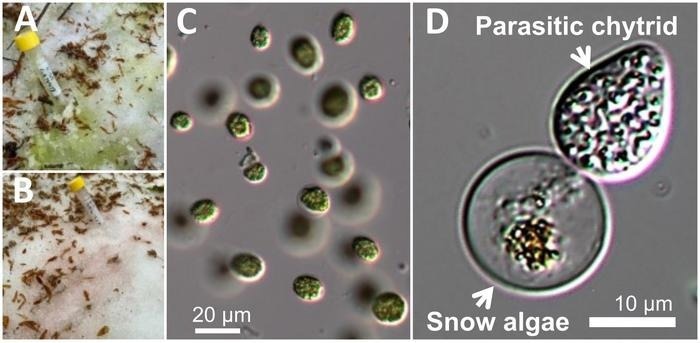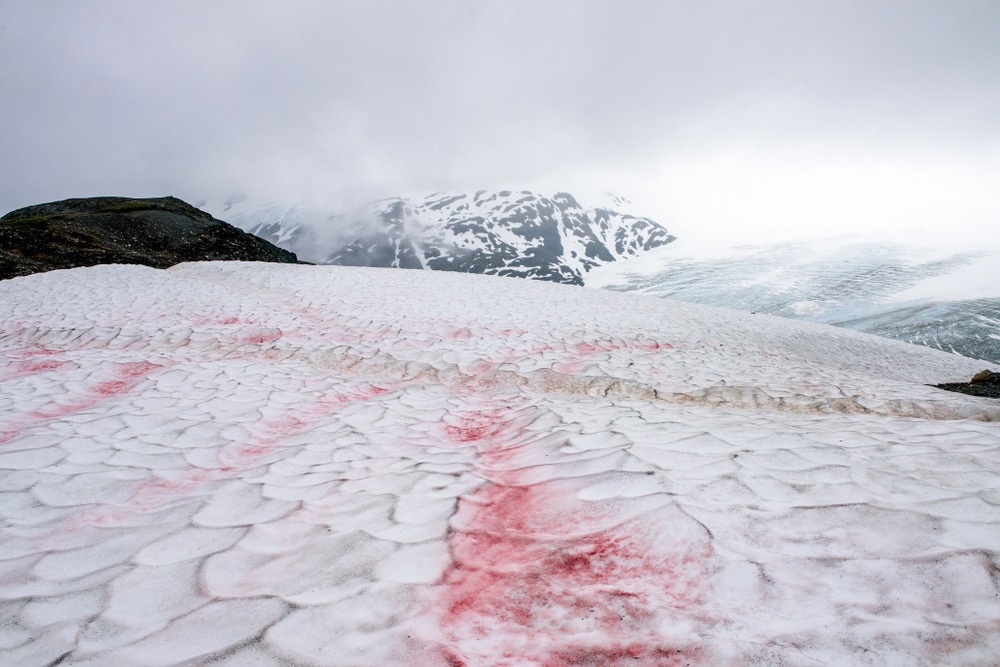Reviewed by Danielle Ellis, B.Sc.Aug 30 2023
Cold weather ecosystems are not complete without the microbial communities found in snowpack and glacier ecosystems. These ecosystems frequently contain large populations of chytrids, a group of fungi that includes well-known frog pathogens, but it has been difficult to culture these organisms and learn more about their lifecycle, including how they relate to the snow algae present there.
 A) Green snow, B) Red snow, C) Snow algae (members of the green algae), which are the main cause of green snow, and D) Parasitic chytrid infecting snow algae. Parasitic chytrids causes host death. Image Credit: Yokohama National University
A) Green snow, B) Red snow, C) Snow algae (members of the green algae), which are the main cause of green snow, and D) Parasitic chytrid infecting snow algae. Parasitic chytrids causes host death. Image Credit: Yokohama National University
Researchers used single-spore PCR to analyze chytrid DNA from two alpine snowpack sites in Japan, according to a recently published study.
On June 20th, 2023, the study was published in Frontiers in Microbiology.
We have captured the chytrids on snow algae and succeeded in extracting DNA from a single spore for the first time in the world. The chytrids detected in cold environments were revealed to be a parasitic species of algae that grow on snowpacks and glaciers, known as snow algae.”
Hiroaki Nakanishi, Study Corresponding Author and Master’s Student, Yokohama National University
Snow algae grow during snowmelt in alpine Japan’s seasonal snowpacks, turning the snow surface red and green. These algae also hasten the melting of snow by enhancing the absorption of solar radiation. Snowmelt from these regions of Japan was found to contain chytrid fungi, but the relationship between the snow algae and the chytrids was unknown.
Recent DNA analysis has revealed that some species of chytrids are able to grow in cold environments. They have been reported to be present under alpine snowpacks or in soil around glaciers, even on top of the snowpacks or glaciers. However, it was unknown if they were parasitic species of some organisms or simply decomposers of organic matter.”
Hiroaki Nakanishi, Study Corresponding Author and Master’s Student, Yokohama National University
Investigators utilized single-spore PCR to sequence chytrids found in a snow alga bloom to better understand their phylogenetic position. Chytrid cells were isolated from green and red snow samples collected from two different locations in Japan.
The Snow Clade was discovered through a molecular phylogenetic analysis of three novel chytrid lineages that are connected to other chytrid lineages found around the world. The first lineage was linked to chytrids found in other snowy climates around the world, including lakes in Switzerland, river water in Alberta, Canada, and snow in Colorado’s Rocky Mountains.

Image Credit: Dene' Miles/Shutterstock.com
The second lineage is linked to chytrids found in glaciers on Tanzania’s Mt. Kilimanjaro. The third lineage was discovered to be completely distinct and independent from the others.
Investigators can confirm that chytrids infect snow algae in the same way that they infect other algae populations around the world using DNA analysis and observation. The chytrids were found in 5.3% of the algae samples, but researchers warn that a low prevalence does not always imply a low impact. Chytrids suppress algal populations in lakes, but infection prevalence is not always high.
More research is needed to fully understand these alpine chytrids and the impact they have on their snowy ecosystems.
It has been shown that the growth of snow algae colors the surface of snow and glaciers and accelerates snowmelt. However, the chytrids may inhibit the melting of glaciers and snowpack by parasitizing and killing snow algae. Chytrids are often considered dangerous because of the well-known frog pathogen, Batrachochytrium dendrobatidis. Further research will help us understand the newly discovered microbial interactions and give some hints to protect glacier ecosystems that are predicted to disappear during the 21st century.”
Maiko Kagami, Study Corresponding Author and Professor, Yokohama National University
Source:
Journal reference:
Nakanishi, H., et al. (2023). Novel parasitic chytrids infecting snow algae in an alpine snow ecosystem in Japan. Frontiers in Microbiology. doi.org/10.3389/fmicb.2023.1201230.